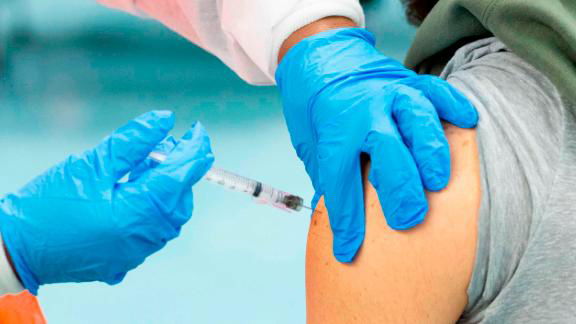COVID-19 spread slows, as California lifts regional order and adjusts vaccine plan
SACRAMENTO, Calif. (KION-TV)
A new week arrives with a flurry of coronavirus pandemic-related changes in California, from the lifting of the Regional Stay at Home Order to a shakeup of the state's vaccine rollout.
VACCINE ROLLOUT CHANGES:
Tuesday, the state announced they are going to bring in a Third Party Administrator (TPA) to simplify the vaccine distribution effort and make sure doses are getting into arms.
California reports more than two million shipped doses, out of nearly 4.7 million total, have not yet been administered.

<script type='text/javascript'> var divElement = document.getElementById('viz1611711299849'); var vizElement = divElement.getElementsByTagName('object')[0]; if ( divElement.offsetWidth > 800 ) { vizElement.style.minWidth='500px';vizElement.style.maxWidth='800px';vizElement.style.width='100%';vizElement.style.height='527px';} else if ( divElement.offsetWidth > 500 ) { vizElement.style.minWidth='500px';vizElement.style.maxWidth='800px';vizElement.style.width='100%';vizElement.style.height='527px';} else { vizElement.style.width='100%';vizElement.style.height='827px';} var scriptElement = document.createElement('script'); scriptElement.src = 'https://public.tableau.com/javascripts/api/viz_v1.js'; vizElement.parentNode.insertBefore(scriptElement, vizElement); </script>A news release sent by California Health and Human Services (CHHS) writes the TPA, not yet announced, will "allocate vaccines directly to providers to maximize distribution efficiency."
Government Operations Agency Secretary Yolanda Richardson says the eventual third-party brings "an opportunity to deliver both healthcare delivery expertise and have some expertise around scale. This is about California being prepared to make sure we can get out the vaccine when more supply is available."
In Tuesday's CHHS news conference, the state says lessons learned during the initial vaccine rollout include, "simplifying vaccine eligibility framework," "standardizing vaccine information and data," and "addressing supply by administering what we have and seeking additional supply."
Counties have complained that they do not receive much notice for how many vaccine doses they receive and, in turn, makes it difficult to schedule vaccine clinics.
The addition of the TPA promises to streamline that state and county vaccine data, including help identifying what providers are not administering the vaccine quickly enough, and if vaccine equity (getting doses to low-income and minority communities) needs to be improved.
California reports they have tripled daily administered doses in recent days and weeks, but figures show they are still behind nationally. According to Bloomberg's vaccine tracker, California ranks 46th out of 50 U.S. states for the percentage of received doses used. The CDC says California is 38th when it comes to doses administered per 100 thousand people.
The slower rollout speed, combined with a desire for better vaccine equity, has led the state to throw out much of the previous vaccine distribution plan. Now, counties and providers are told to immediately begin administering the vaccine to:
- People aged 65+
- Education and child care
- Emergency services
- Food and agriculture workers
After seniors and the highest-risk and highest-exposure occupation groups, the state says they will turn to an age-based system. This means the previously listed, and remaining, essential workers and people age 16-64 with high-risk medical conditions, for now, are not going to be prioritized.
KION is also told there is little guidance to the counties for how this should happen, with such a limited supply and such a large group of people now eligible. Monterey, Santa Cruz and San Benito counties have indicated they are gong to begin vaccinating the 75+ group first.
"We are faced, right now, on having to allocate a scare resource to where it is going to do the most good at this point. Obviously that is going to make some groups unhappy. We understand that and we sympathize with that, but we really don't have much choice at this point," says Santa Cruz Deputy Health Officer Dr. David Ghilarducci.
Santa Cruz County has started vaccination clinics at the Santa Cruz County Fairgrounds, but they are only for people age 75+, residents in certain Watsonville zip codes, and people have to register in advance.
Dr. Ghilarducci is also the Health Officer for San Benito County. He says they might have more ability to vaccinate the prioritized occupation groups early.
The issue is there are only so many vaccine doses to go around. Monterey County reported Tuesday that they only receive about two thousand to four thousand doses a week. At this current rate, it would take more than twenty weeks to get through their estimated 86,471 residents age 65 and older.
"Those occupation groups who you just mentioned are going to be pushed back some months, some probably May, or even June for some of these groups, which is disheartening. Another equity piece is schools reopening and getting teachers protected," says Dr. Ghilarducci. "We want to get kids back to school, especially kids in communities that don't have as many resources."
REGIONAL STAY AT HOME ORDER ENDS:
Monday morning, California announced that Governor Gavin Newsom is ending the highly restrictive Regional Stay at Home Order. The decision was made due to state formulas, now released after criticism, showing ICU availability projected to rise above the 15 percent threshold.
The lifting of the order means the state is going back to the "tier" system, with all but four counties remaining in the most restrictive "purple" or "widespread" tier. However, this still allows many parts of the economy and activities to open back up, including outdoor dining, outdoor gatherings with up to three households, personal care services, and hair salons/barbershops.
Monterey, Santa Cruz and San Benito counties are all in the "purple" tier, with their case rate and test positivity rate above the threshold needed to advance to the less-restrictive "red" tier, which would open even more businesses for indoor operations.
While controversial, Health and Human Services Secretary Dr. Mark Ghaly says the Regional order worked to slow the spread of the virus. In Tuesday's news conference, he points to projections that show the order likely decreased hospitalizations by 25,000 and ICU admissions by 5000 in the month and a half it was active.
California's 14-day positivity rate is now 9.0 percent. It was 13.5 percent on January 12th. Hospitalizations have decreased by 20.4 percent over the last 14 days.
However, the Regional Stay at Home order has been criticized for restricting the economy. California's unemployment rate in December was 9.0, the 3rd highest in the country. Dr. Ghaly was asked, Tuesday, to respond to criticism that outdoor dining was banned despite a lack of data pointing to the activity being a large cause of COVID-19 transmission. He answered that the goal was to stop people from traveling and gathering outside their household.



